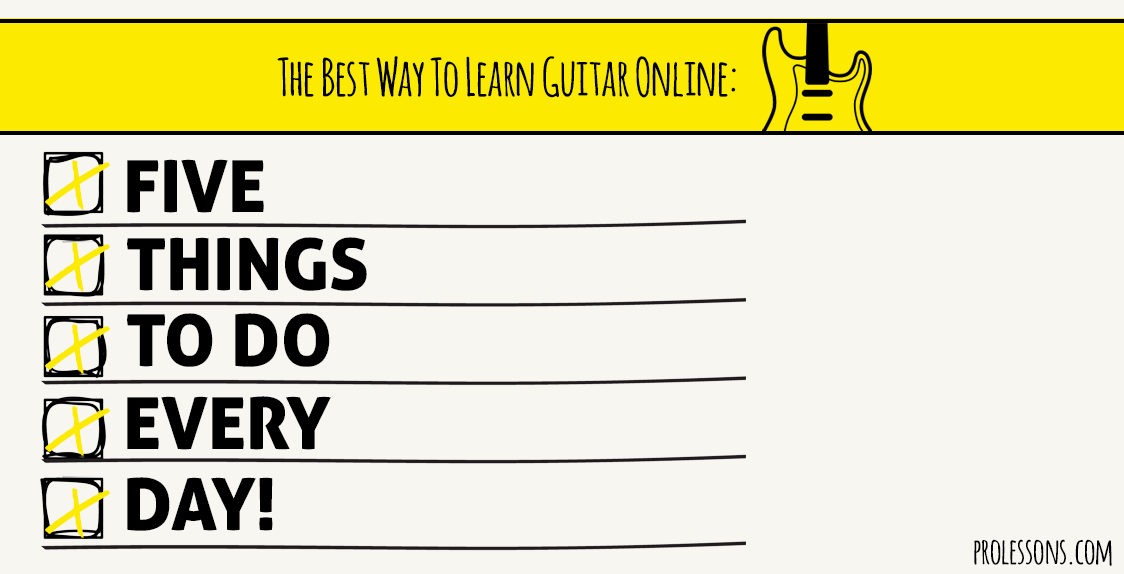FREE LESSON
PHIL KEAGGY - Grammy nominated and seven-time Dove Award winner, is one of the world’s great guitar players and a pioneer in contemporary Christian music.

Habits are a funny thing. Bad ones can send you on a downward spiral and good ones can help you achieve even the loftiest goals. So you want to learn to play guitar--wise choice. You've signed up for guitar online and played through some lessons of the videos. What now?
With traditional one-on-one instruction,you have a guitar instructor guiding you through the process. Buy if you're solely learning guitar online, you have to be a self starter. Here are five things you can do every day when learning guitar online to ensure your success and eventual mastery of the guitar.
At the onset of every practice session, it's important to tune before you start playing. If you do this, you're actually killing two birds with one stone. While you're working away on songs and techniques, you are also training your ears. Yep, every single note you play is being registered, and your "ear brain" is working overtime soaking up all sorts of information that you're not even aware of.
Conversely, if you skip tuning, you're training your ear wrong. It gets used to accepting muddled groups of sharp and flat notes as "okay". That's not okay, because ear training is possibly the single most practical and important part of becoming a great musician. So give yourself a good head start by ensuring that your guitar is tuned up as soon as you get started.
Over at ProLessons.com, there is a plethora of great warm up videos. It seems like every pro musician has his or her own warm up regimen. There are a few reasons for this. When you play guitar, you are using micro muscles in your fingers that you don't use for anything else in life. After a few hours of not playing, these muscles can feel a little stiff and rigid. After a great warm up you start to feel loose and nimble.
If you're ever backstage before a show, you can catch your favorite player going through a quick warm up to get everything feeling good. That's the same way you should approach each practice session. Do a few quick exercises to get the blood flowing.
The second reason to have a good warm up routine is this: just like an athlete has certain injuries that are related to their sport (such as runners and plantar fasciitis, volleyball players and shoulder dislocations, etc.), a professional guitarist's nemesis is a nasty little wrist affliction known as Carpal tunnel. Part of avoiding Carpal tunnel is staying loose and limber. So take a look at all of the pros' warm up videos, try them out, and either adopt one of their routines or come up with one of your own.
When learning guitar online set realistic goals for yourself and chip away at them every day. We often recommend a half hour a day practice session for any guitarist who wants to improve. It's a pretty easy little goal to meet once you get used to it. Basically, the time you'd spend watching one TV show can be invested in becoming a great musician.
Oftentimes, this half hour will wind up stretching on for hours as you find yourself heavily involved in a piece of music that you're really trying to master--you'll look up and wonder where the time went. Then there's the other times when you're just not feeling it, and one half hour drags on like a slow day at a dead end job. Either way, meet your daily commitment and you'll be thankful in the long run. Consistency is key to becoming a great musician! "Don't count the days, make the days count." -Muhammad Ali

There was a sign posted in the practice hall of Milano's Music in Mesa, Arizona. The sign read "Early to bed, early to rise, early to practice is very wise," and there a picture of an owl in a graduation cap holding a Les Paul. Even if you're not a morning person, this rock n' roll owl (who apparently just graduated?) is to be taken seriously.
When learning guitar online try to incorporate an early practice sesh into your routine. Remember, the target time is only a half hour a day, so worst case scenario, you are setting the alarm back 30 minutes. Obviously, you're going to want to meet your sleep quota, so this might mean missing out on 1/2 hour of late night TV. Try it for a few weeks and give your body time to adjust. I guarantee you're going to get some serious sparks of creativity and breakthrough moments in those early sessions when your mind is fresh and clear. It might even be enough to turn you night owls into early birds... pun intended.
So this may not make a huge difference when you're playing for 1/2 hour a day... But on those marathon sessions, it will make all the difference in the world. Find a good, adjustable chair (preferably without arms) and get comfortable. Also put your strap on and walk around as you practice. This will keep the mechanics of what you're doing working for you instead of against you.
Standing and walking around has the added benefit of prepping you for stage work. People see music with their eyes, so getting up and getting mobile is a crucial part of most performance styles. If you're a classical guitarist feel free to stay seated, but if you want to rock,you need to jump around a little. Pro Tip- As part of your good posture, make sure that your left wrist (for right handed guitarists) isn't cranked at a weird angle and don't hold the same position for too long. These are the main two causes of Carpel Tunnel, which usually only affects the uber dedicated, 8 hours a day practicers... but better safe than sorry.
There you have it. Follow these five simple steps and you will improve dramatically. Add in a healthy dose of live performing and fresh practice material, and the sky's the limit. Here are a few suggestions for a 30 minute practice session just to get the wheels turning:
Oh ya, this is just scratching the surface. To dive in deeper click the link below to start you true musical journey. We’ll see you there.